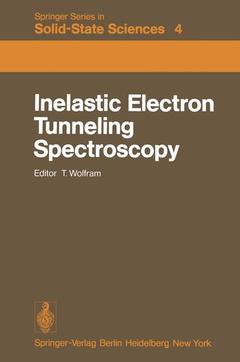Description
Inelastic Electron Tunneling Spectroscopy, Softcover reprint of the original 1st ed. 1978
Proceedings of the International Conference, and Symposium on Electron Tunneling University of Missouri-Columbia, USA, May 25–27, 1977
Springer Series in Solid-State Sciences Series, Vol. 4
Coordinator: Wolfram T.
Language: English
Subject for Inelastic Electron Tunneling Spectroscopy:
Inelastic Electron Tunneling Spectroscopy
Publication date: 04-1978
Publication date: 04-1978
Inelastic Electron Tunneling Spectroscopy
Publication date: 01-2012
242 p. · 15.5x23.5 cm · Paperback
Publication date: 01-2012
242 p. · 15.5x23.5 cm · Paperback
Description
/li>Contents
/li>
Inelastic Electron Tunneling Spectroscop~ or lETS, provides a unique technique for electronically monitoring the vibrational modes of molecul (;5 adsorbed on a metal oxide surface. Since the discovery of the phenomena by JAKLEVIC and LM1BE in 1966, lETS has been developed by a number of scientists as a method for studying the surface chemistry of molecular species adsorbed on aluminum oxide. Recent applications of lETS include investigations of physical and chemical adsorption of hydrocarbons, studies of catalysis by metal particles, detection and identification of trace substances in air and water, and studies of biological molecules and electron damage to such molecules. lETS has been employed to investigate adhesive materials, and studies are currently in prog ress to investigate corrosion species and corrosion inhibitors on aluminum and its alloys. Electronic transitions of molecules have also been studied by lETS. The recent development of the "external doping" technique, whereby molecu lar species can be introduced into fabricated tunnel junctions, opens the door for a vast new array of surface chemical studies by lETS. lETS is rap idly becoming an important tool for the study of surface and interface phe nomena. In addition to its role in surface studies, inelastic tunneling has proved extremely valuable for the study of the electronic properties of thin metallic films, and the recent discovery of light emission from inelastic tunneling promises to be of some importance in the area of device physics.
I. Review of Inelastic Electron Tunneling.- Inelastic Electron Tunneling Spectroscopy (IETS) - Past and Future.- Survey of Applications of Tunneling Spectroscopy.- II. Applications of Inelastic Electron Tunneling.- Application of IETS to Surface Chemistry and Heterogeneous Catalysis.- IETS with Applications to Biology and Surface Physics.- Application of IETS to Trace Substance Detection.- Application of IETS to the Study of Adhesion.- III. Theoretical Aspects of Electron Tunneling.- Theoretical Interpretation of IETS Data.- A Model for Electron-Molecule Interaction in IETS.- Theory of Surface-Plasmon Excitation by Electron Tunneling.- Inelastic Scattering of Low Energy Electron Beams by Surface Vibrations: The Nature of the Image Force.- Effect of Cooperative Behavior on Molecular Vibrational IETS Peak Intensities.- The Golden Rule Formalism in Electron Tunneling. Can It Be Justified?.- Calculations of Inelastic Tunneling Cross Sections Using Self-Consistent Multiple Scattering Techniques.- IV. Discussions and Comments.- The Technology of IETS.- Problems in the Biological Sciences.- Relation of IETS to Other Surface Studies.- V. Molecular Adsorption on Non-Metallic Surfaces.- Photoemission Studies of Molecular Adsorption on Oxide Surfaces.- Application of Neutron Scattering to the Study of the Structure and Dynamics of Short-Chain Hydrocarbons Adsorbed on Small Particles.- VI. New Applications of IETS.- Study of Supported Catalyst Particles by Tunneling Spectroscopy.- External Doping of Tunnel Junctions.- Electronic Transitions Observed by Inelastic Electron Tunneling Spectroscopy.- Light Emission From Inelastic Tunneling - LEIT.- VII. Elastic Tunneling.- Zero Bias Anomalies in Tunneling: A Review.- Superconducting Tunneling.- Phonon Damping of Virtual Levels in Thick Superconducting Films.- Tunneling With Spin Polarized Electrons.- Semiconductor Tunneling, Bound Levels and Band Structure.- Organization of Conference and Symposium.- Program of Conference.- Program of Symposium.
© 2024 LAVOISIER S.A.S.




